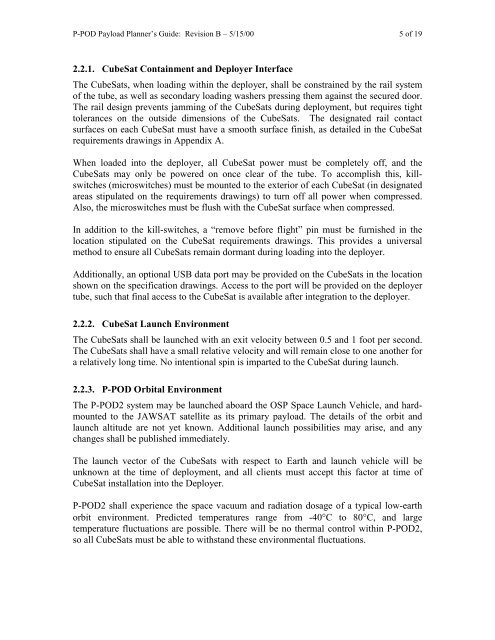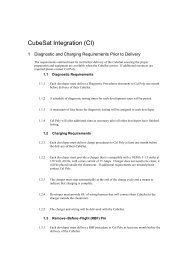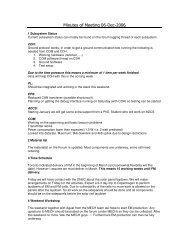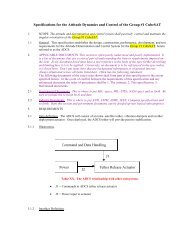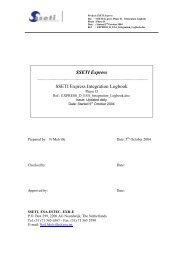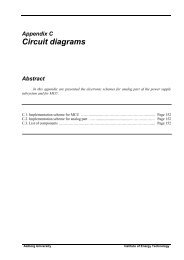The P-POD Payload Planner's Guide
The P-POD Payload Planner's Guide
The P-POD Payload Planner's Guide
You also want an ePaper? Increase the reach of your titles
YUMPU automatically turns print PDFs into web optimized ePapers that Google loves.
P-<strong>POD</strong> <strong>Payload</strong> Planner’s <strong>Guide</strong>: Revision B – 5/15/00 5 of 19<br />
2.2.1. CubeSat Containment and Deployer Interface<br />
<strong>The</strong> CubeSats, when loading within the deployer, shall be constrained by the rail system<br />
of the tube, as well as secondary loading washers pressing them against the secured door.<br />
<strong>The</strong> rail design prevents jamming of the CubeSats during deployment, but requires tight<br />
tolerances on the outside dimensions of the CubeSats. <strong>The</strong> designated rail contact<br />
surfaces on each CubeSat must have a smooth surface finish, as detailed in the CubeSat<br />
requirements drawings in Appendix A.<br />
When loaded into the deployer, all CubeSat power must be completely off, and the<br />
CubeSats may only be powered on once clear of the tube. To accomplish this, killswitches<br />
(microswitches) must be mounted to the exterior of each CubeSat (in designated<br />
areas stipulated on the requirements drawings) to turn off all power when compressed.<br />
Also, the microswitches must be flush with the CubeSat surface when compressed.<br />
In addition to the kill-switches, a “remove before flight” pin must be furnished in the<br />
location stipulated on the CubeSat requirements drawings. This provides a universal<br />
method to ensure all CubeSats remain dormant during loading into the deployer.<br />
Additionally, an optional USB data port may be provided on the CubeSats in the location<br />
shown on the specification drawings. Access to the port will be provided on the deployer<br />
tube, such that final access to the CubeSat is available after integration to the deployer.<br />
2.2.2. CubeSat Launch Environment<br />
<strong>The</strong> CubeSats shall be launched with an exit velocity between 0.5 and 1 foot per second.<br />
<strong>The</strong> CubeSats shall have a small relative velocity and will remain close to one another for<br />
a relatively long time. No intentional spin is imparted to the CubeSat during launch.<br />
2.2.3. P-<strong>POD</strong> Orbital Environment<br />
<strong>The</strong> P-<strong>POD</strong>2 system may be launched aboard the OSP Space Launch Vehicle, and hardmounted<br />
to the JAWSAT satellite as its primary payload. <strong>The</strong> details of the orbit and<br />
launch altitude are not yet known. Additional launch possibilities may arise, and any<br />
changes shall be published immediately.<br />
<strong>The</strong> launch vector of the CubeSats with respect to Earth and launch vehicle will be<br />
unknown at the time of deployment, and all clients must accept this factor at time of<br />
CubeSat installation into the Deployer.<br />
P-<strong>POD</strong>2 shall experience the space vacuum and radiation dosage of a typical low-earth<br />
orbit environment. Predicted temperatures range from -40°C to 80°C, and large<br />
temperature fluctuations are possible. <strong>The</strong>re will be no thermal control within P-<strong>POD</strong>2,<br />
so all CubeSats must be able to withstand these environmental fluctuations.


